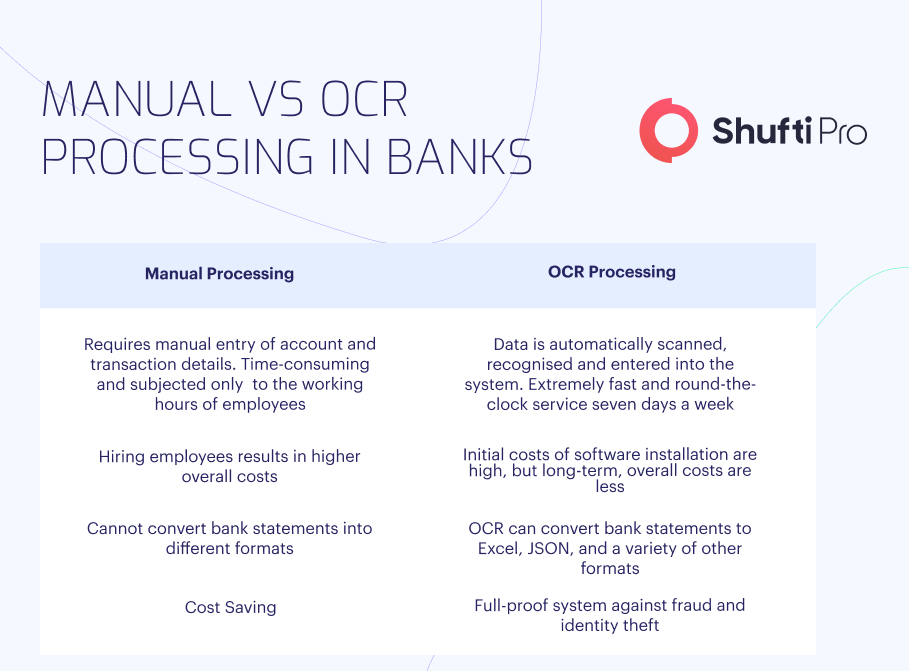How Optical Character Recognition is Changing the Financial Industry

- 01 The Effects of OCR on the Financial Sector in 2023
- 02 Document Digitisation with OCR
- 03 Where in the Financial Sector Is OCR Optimisable?
- 04 OCR Applications in Banking
- 05 What Role Does OCR Play in Intelligent Document Processing?
- 06 Importance of OCR for Financial Spreading
- 07 How can Shufi Pro Help?
Banking and other financial services are the world’s most closely watched and strictly governed industries. Due to the high volume of monetary devices, the sector places a premium on tools that meet the highest safety, precision, and efficiency standards. OCR automation services, including banking, are widely used in many modern business sectors. OCR technology aims to convert scanned or image-based text files into structured, editable, and searchable machine-readable text. AI-Powered OCR made banking more accessible, faster, and more efficient. With optical character recognition, banks can process, monitor, and analyse vast amounts of client information, like personal and security information in real time.
OCR has emerged as a critical component of modern business operations. By 2030’s end, the worldwide OCR market is expected to be worth $70 million. Optical character recognition relies on the ability to digitise printed text so that a computer can read it. It uses Natural Language Processing (NLP) technology to pick out individual letters and characters, replicating them in the correct printed order. Financial institutions are implementing OCR technology to serve clients better. Furthermore, financial institutions employ this technology for authentication and risk mitigation.
The Effects of OCR on the Financial Sector in 2023
OCR is now widely used in the banking and financial industry. There are a variety of applications for the technology:
Systems for Retrieving Documents
OCR technology easily converts scanned and photographed documents into a machine-readable version. This is crucial for document repositories, where thousands of items must be organised, accessed and sorted according to specific criteria. Improved system efficiency and compliance with severe security criteria imposed by authorities result from the ease with which financial records may now be accessed.
Modifying Scanned Files
When modifying financial documents, OCR is the first step. Converting documents into a format that computers can read makes it simpler to change the underlying data. It is possible to add, remove, replace, rotate, reorganise, and extract pages from a PDF using any of several available editors.
Document Digitisation with OCR
AI-enhanced OCR is used in the banking industry and other financial institutions to digitise documents rapidly and accurately. It expedites access to information for customers and helps banks cut down on paper use and processing time for documents. With OCR technology, financial institutions may save time and money on document processing and data entry. It also helps financial institutions spot fraud by checking documents for forgery or tampering.
The three-step procedure for automating invoice form OCR data extraction is as follows:
Pre-Processing
First, the equipment, which can be any optical scanner, converts the physical form of the record into an electronic image. For instance, if a report is printed, the machinery component can send a high-tech copy of the same repository. During this phase, OCR technology must identify the essential parts of the image. In this case, you should only focus on the text-filled spaces and disregard the rest. This pattern is often described as the image transitioning between a white transparent background and a black, opaque foreground.
Character Recognition
After the characters and backgrounds have been isolated, the next step is to extract the text from the scanned papers. The dark patches or characters represent the numbers and letters. These aspects are studied in bite-sized chunks rather than in one massive investigation. If the content is straightforward and the AI can decipher the language and characters, this usually refers to a single word at a time. Character recognition can be accomplished in different ways, the most common of which are pattern recognition and feature extraction.
Post Processing
Character by character, a given record’s contents are eventually identified, converted to an ASCII code, and filled away for letter use. Even the most well-designed frameworks have flaws, so don’t expect perfection. That’s why most OCR systems have a step after processing when double-checking the result. For example, the letter ‘O’ and the number ‘0’ might look very similar when written by hand. Because of this, the post-processing phase is crucial for accuracy.

Where in the Financial Sector Is OCR Optimisable?
There is mounting demand for financial institutions to digitise their processes and increase efficiency, but doing so too quickly can lead to technical debt and unnecessary technology expenditures. Executives in the financial services industry would familiarise themselves with the scenarios in which OCR applications can be helpful and how these technologies might integrate with existing finance, risk, customer, and data infrastructure. As such, we have compiled the most common applications of OCR:
Know Your Customer (KYC)
Improving client onboarding for KYC processes is a significant use case for OCR. Customers complete forms with personal information and upload scanned documents with the same information, which a staff member must confirm. With each new potential customer, the client and the employee must go through the time-consuming process of manually uploading data and guaranteeing quality checks again. This causes unnecessary work and sometimes leads to inaccurate data comparisons. OCR systems are being implemented to automate this procedure, and AI capabilities are being used to validate the client’s data.
Client Onboarding and the Application Processing
Discovery Life, a major insurer in South Africa, has just released an online document upload and rapid quote system using OCR-based artificial intelligence (AI). Before this change was made, data extraction and processing were done manually. The OCR quotation system can automatically recognise, extract, and analyse the pertinent text to generate quotes by uploading these documents.
For retail banking, a primary Asian financial services provider called DBS Bank uses optical character recognition technology to streamline and improve the customer experience, making it easier for clients to apply for personal loans and shortening the time it takes to receive approval. Customers can quickly provide proof of identity and paperwork by uploading images. The loan application fields the consumer typically fills out by hand are then automatically populated using OCR technology.
Companies in highly competitive industries, like insurance and banking, can gain a competitive edge by delivering faster turnaround times for customer bids and applications.
Invoice Processing
A portion of Citibank’s trade operations was digitised and automated using an OCR solution. Physical documents, typically in multiple languages and with various signatories, play an essential role in international trade. Invoices, shipping confirmations, and bills of lading are just some documents that OCR software may scan and process to extract and retain valuable financial and logistical information. This has reduced processing time and strengthened risk controls across the data extraction process, leading to a better supply chain experience.
OCR Applications in Banking
A few years ago, even ordinary bank transactions took 5 to 7 business days but are now instant? However, OCR has proven crucial in significantly accelerating the process. Banking has been revolutionised by OCR and other digital technology, which is a massive boon to the financial sector.
Young adults today (those aged 25 to 35) who remember going to the bank with their parents as a tedious, time-consuming, and unpleasant exercise can now accomplish incredible feats with the tap of a finger. When OCR wasn’t available, processing times were lengthier because of human error and the sheer volume of paper documents. The bank wasted valuable time on mundane tasks like cashing checks and processing bank statements to keep its resources busy.
In 2023, data from a cheque can be entered into a computerised system without needing specialised personnel. The serial number, amount, IFSC code, account number, and signature may all be scanned by OCR when it reads a cheque from top to bottom. When these components are recognised, the system will immediately update the appropriate section of the bank’s database. However, before discussing OCR’s applications in the banking industry, it is essential to understand the technology’s foundational principles.
If banking is rapid, the world is quick, and the straightforward integration of these three core ideas dramatically accelerates monetary transactions across the globe.
What Role Does OCR Play in Intelligent Document Processing?
OCR training datasets, connections, and critical values are utilised by Intelligent Document Processing (IDP). In addition, it offers more knowledge via cutting-edge AI services based on machine learning. The recogniser is a document-optimised reader OCR engine that may be used as a delegation mechanism to access more advanced models. Text can be pulled from digital or scanned materials using OCR technology.
Importance of OCR for Financial Spreading
First, optical character recognition is not a novel method for producing digitised financial reports and papers. What changes the game is the relatively new integration of OCR with AI solutions. In the past, OCR software used physical papers as templates to extract data accurately. Both mental effort (in the form of data extraction from unstructured sources) and physical exertion (in the form of data entry from one programme to another) were required to complete the task. Because of the extensive human involvement required, the procedure was impractical because of the time and money needed to repeat it for each new document.
Businesses and organisations of all sizes can improve risk management practises with the help of OCR services powered by Artificial Intelligence (AI), which can be used to digitise and securely store sensitive documents and reports in the cloud and run a variety of intelligent and machine learning procedures on them. Let’s analyse the different ways in which OCR might help strengthen financial risk management.
Enterprise Data Intelligence
Intelligent Data Capture (IDC) and Machine Learning (ML) in the cloud elevate OCR to a whole new level of complexity. There is no longer any need for humans to play any part in acquiring business process knowledge thanks to advancements in natural language processing, computer vision technology, and machine learning techniques.
Improves the Way Risks are Handled
Integrating AI OCR with machine learning systems has the potential to streamline and accelerate complicated credit risk operations that previously required manual data entry and analysis. By utilising this centralised platform, credit risk assessment teams may better analyse high-risk accounts and parties, refine credit choices, and provide customers with innovative, tailor-made financial products and services. Provide outstanding customer service from beginning to end, and make decisions in minutes rather than weeks.
Eliminate Human Intervention and Cut Costs
Human resources were needed to design rules and templates in traditional OCR systems, which increased operating expenses, slowed down procedures, and produced inaccurate results. OCR scanners are now superior to manual data entry and information extraction in speed, precision, efficiency, and cost-effectiveness.
How can Shufi Pro Help?
Shufi Pro stands as a powerful solution that has the potential to streamline data extraction processes significantly. Its advanced OCR technology empowers it to capture data from various documents in seconds effortlessly. This transformative capability extends to structured and unstructured documents, making it a versatile tool for diverse applications. Furthermore, its support for multilingual documents and extensive global coverage across more than 150 languages demonstrates its adaptability and accessibility on a global scale. As businesses and individuals grapple with the challenges of managing and extracting valuable insights from large volumes of information, Shufti emerges as a game-changer, offering efficiency, accuracy, and convenience in harnessing data from various sources. Whether for businesses seeking to enhance productivity or individuals striving for more efficient information management, Shufti’s OCR technology holds the potential to drive meaningful and tangible improvements across the board.
Want to know more about how Shufti helps in the financial industry?










